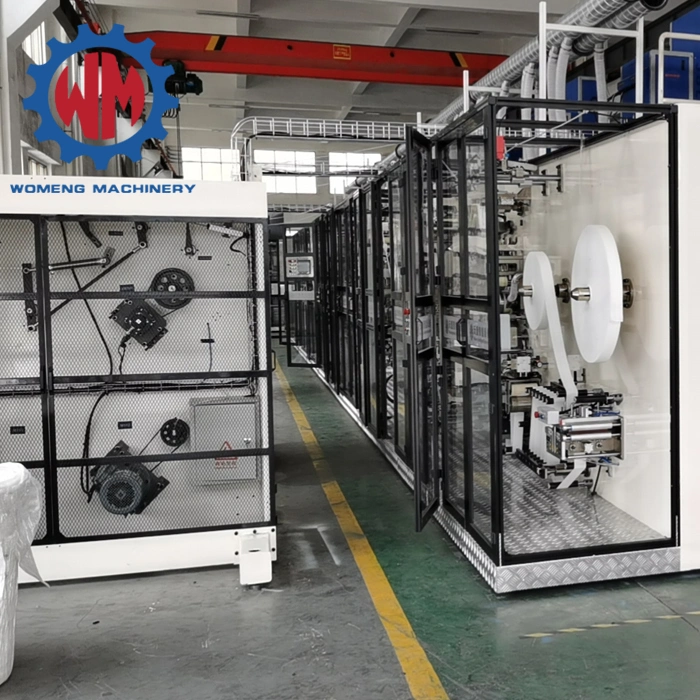Engineering a full servo sanitary napkin machine with considerations for evolving market trends and consumer preferences involves several key aspects:
- Flexibility in Product Variations: Designing the machine to accommodate a wide range of product variations, such as different sizes, shapes, absorbency levels, and features. This flexibility allows quick adjustments to meet changing consumer demands.
- Modular Design: Implementing a modular design that allows easy customization and reconfiguration of machine components. This modularity enables the addition or alteration of features to align with emerging trends or preferences.
- Quick Changeover Capabilities: Incorporating features that facilitate rapid changeovers between different product configurations. Minimizing downtime during transitions helps in adapting to market changes swiftly.
- Material Compatibility: Ensuring the machine can handle various eco-friendly and sustainable materials that align with changing consumer preferences, such as biodegradable or recycled materials.
- Customizable Features: Providing options for customizable features in the production process, such as unique designs, embossing, or patterns that cater to evolving consumer preferences for aesthetics and functionality.
- Efficient Prototyping and Testing: Adopting agile engineering practices that enable rapid prototyping and testing of new product variations. This approach allows for quicker validation of market acceptance and consumer feedback.
- Data Analytics for Trend Analysis: Implementing data analytics tools to analyze market trends, consumer behavior, and preferences. This data helps in forecasting demand and adapting production accordingly.
- Consumer-Centric Innovation: Encouraging a culture of innovation that is centered around understanding and responding to consumer needs and preferences. Gathering insights through market research and consumer feedback aids in designing products that resonate with the target audience.
- Sustainability Integration: Considering consumer preferences for eco-friendly products and incorporating sustainable practices into the machine design. This includes minimizing waste, using environmentally friendly materials, and reducing energy consumption.
- User Interface and Experience: Designing user-friendly interfaces for operators to easily configure the machine settings for different product variations. Ensuring ease of use facilitates quicker adaptation to changing market demands.
By integrating these engineering considerations into the design and functionality of a full servo sanitary napkin machine, manufacturers can better align their production capabilities with evolving market trends and consumer preferences, full servo sanitary napkin machine factory fostering agility and responsiveness in meeting dynamic market demands.
How do engineers ensure the scalability and adaptability of full servo sanitary napkin machine designs to meet future demands and technological advancements?
Engineers ensure the scalability and adaptability of full servo sanitary napkin machine designs to meet future demands and technological advancements through various strategies:
- Modular Design Approach: Implementing a modular design that allows for easy integration of new components or functionalities. Modular systems facilitate scalability by enabling the addition or replacement of modules to accommodate increased production capacity or technological advancements.
- Flexible Configurations: Designing machines with flexible configurations that can be easily adjusted or expanded to meet changing production requirements. This adaptability allows the machine to grow or evolve alongside market demands.
- Compatibility with Advanced Materials: Ensuring the machine’s compatibility with advanced and innovative materials that may emerge in the future. This includes materials with enhanced absorbency, sustainability features, or new properties.
- Upgradability and Retrofitting: Designing machines with the capability to undergo upgrades or retrofits to incorporate new technologies, sensors, automation systems, or improved components. This approach allows for continuous improvement without requiring a complete redesign.
- Scalable Production Capacity: Engineering machines with scalability in production capacity, allowing for easy scaling up or down of output levels based on market demands. This scalability ensures efficient utilization of resources.
- Future-Proof Controls and Software: Using adaptable control systems and software architectures that can accommodate future advancements in technology. This includes ensuring compatibility with new communication protocols, IoT integration, and advanced analytics.
- Continuous Research and Development: Investing in ongoing research and development to stay abreast of technological advancements in the industry. Incorporating emerging technologies into the machine design ensures relevance in the market.
- Standardization and Compatibility: Adhering to industry standards and ensuring compatibility with standardized components and interfaces. Standardization facilitates interchangeability and integration of new components or upgrades.
- Collaboration with Suppliers and Partners: Engaging with suppliers and industry partners to explore new technologies, materials, and innovative solutions. Collaboration helps in leveraging external expertise and staying updated with industry advancements.
- Future-Ready Training and Support: Providing training and support programs that equip operators and maintenance personnel with the skills needed to handle future advancements or upgrades in machine technology.
By considering these strategies in the initial design phase and throughout the machine’s lifecycle, engineers ensure that full servo sanitary napkin machine designs remain scalable, adaptable, and capable of incorporating future technological advancements, allowing manufacturers to stay competitive and responsive to evolving market needs.
